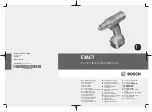
5
ENGLISH
d )
Store idle power tools out of the reach of children
and do not allow persons unfamiliar with the
power tool or these instructions to operate the
power tool.
Power tools are dangerous in the hands
of untrained users.
e )
Maintain power tools.
Check for misalignment or
binding of moving parts, breakage of parts and
any other condition that may affect the power
tools's operation. If damaged, have the power
tool repaired before use.
Many accidents are
caused by poorly maintained power tools.
f )
Keep cutting tools sharp and clean.
Properly
maintained cutting tools with sharp cutting edges are
less likely to bind and are easier to control.
g )
Use the power tool, accessories and tool bits, etc.
in accordance with these instructions, taking
into account the working conditions and the
work to be performed.
Use of the power tool for
operations different from those intended could result
in a hazardous situation.
h )
Keep handles and grasping surfaces dry, clean
and free from oil and grease.
Slippery handles and
grasping surfaces do not allow for safe handling and
control of the tool in unexpected situations.
Battery Tool Use and Care
a )
Recharge only with the charger specified by the
manufacturer.
A charger that is suitable for one type
of battery may create a risk of fire when used with
another battery pack.
b )
Use power tools only with specifically designated
batterys.
Use of any other batterys may create a risk
of injury and fire.
c )
When the battery is not in use, keep it away from
other metal objects, like paper clips, coins, keys, nails,
screws, or other small metal objects, that can make a
connection from one terminal to another.
Shorting the
battery terminals together may cause burns or a fire.
d )
Under abusive conditions, liquid may be ejected
from the battery; avoid contact. If contact
accidentally occurs, flush with water.
If liquid
contacts eyes, additionally seek medical help. Liquid
ejected from the battery may cause irritation or burns.
e )
Do not use a battery pack or tool that is amaged
or modified.
Damaged or modified batteries may
exhibit unpredictable behaviour resulting in fire,
explosion or risk of injury.
f )
Do not expose a battery pack or tool to fire
or excessive temperature.
Exposure to fire or
temperature above 130 °C may cause explosion.
g )
Follow all charging instructions and do not
charge the battery pack or tool outside the
temperature range specified in the instructions.
Charging improperly or at temperatures outside the
specified range may damage the battery and increase
the risk of fire.
Service
a )
Have your power tool serviced by a qualified
repair person using only identical replacement
parts.
This will ensure that the safety of the power
tool is maintained.
b )
Never service damaged battery packs.
Service
of battery packs should only be performed by the
manufacturer or authorized service providers.
Additional Safety Rules for Screwdrivers
•
Hold power tool by insulated grippng surfaces,
when performing an operation where the fastener
may contact hidden wiring or its own cord.
Fasteners contacting a “live” wire may make exposed
metal parts of the power tool “live” and could give the
operator an electric shock.
• The device is not intended for use by persons (including
children) with reduced physical, sensory or mental
capabilities, or lack of experience or knowledge, unless
they are supervised or instructed in its use by a person
responsible for their safety.
• Children must be monitored to ensure they do not play
with the appliance.
Electrical Safety
Your tool is double insulated; therefore no earth
wire is required. Always check that the main voltage
corresponds to the voltage on the rating plate.
WARNING! If the power cord is damaged,
it must be replaced by the manufacturer,
authorized BLACK+DECKER Service Center or
an equally qualified person in order to avoid
damage or injury.
If the power cord is replaced by
an equally qualified person, but not authorized by
BLACK+DECKER, the warranty will not be valid.
Labels on Tool
The label on your tool may include the following symbols. The
symbols and their definitions are as follows:
V ......................... volts
Hz .......................hertz
min .....................minutes
or DC ......direct current
...................... Class I Construction
(grounded)
…/min ..............per minute
BPM ....................beats per minute
IPM .....................impacts per minute
RPM .................... revolutions per
minute
sfpm ................... surface feet per
minute
SPM ....................strokes per minute
A .........................amperes
W ........................watts
or AC ...........alternating current
or AC/DC .... alternating or
direct current
...................... Class II
Construction
(double insulated)
no .......................no load speed
n .........................rated speed
......................earthing terminal
.....................safety alert symbol
.....................visible radiation
Summary of Contents for BD40
Page 2: ...English 3 12 19 27 Bahasa Indonesia 36 46 Ti ng Vi t 57...
Page 12: ...12 3 1 2 3 4 5 Micro USB 6 Micro USB BD40K27 7 A 1 2 5 6 3 4 7...
Page 26: ...26 3 1 2 3 4 5 USB 6 USB BD40K27 7 1 2 5 6 3 4 7 A...
Page 34: ...34 11 BLACK DECKER 4 5 C 40 F 40 5 C 105 F 1577 0933...
Page 45: ...45 3 1 2 3 4 5 Micro USB 6 Micro USB BD40K27 7 A 1 2 5 6 3 4 7...
Page 46: ...46 4 BLACK DECKER RCD RCD RCD GFCI ELCB...
Page 47: ...47 5 130 C...
Page 50: ...50 8 1 65 F 75 F 18 24 C 40 F 4 5 C 104 F 40 C 2 3 65 F 75 F 18 24 C 4 5 6 1 2 2 BLACK DECKER...
Page 52: ...52 10 B 1 4 6 35 1 7 2 7 B 7 C 1 7 E clutch 5 5 1 5 1 5...
Page 67: ......
Page 68: ...07 2019...






































